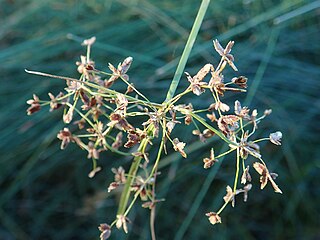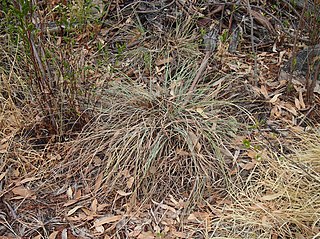
Cyperus polystachyos, also known as Pycreus polystachyos, and also called manyspike flatsedge in the US, or bunchy sedge, coast flatsedge, many-spiked sedge or Texas sedge in Australia, is a herbaceous species in the family Cyperaceae, widespread in tropical and subtropical areas around the world, sometimes extending its range into temperate regions.
Cyperus alopecuroides, commonly known as the foxtail flatsedge, is a sedge of the family Cyperaceae that is native to parts of Africa, Asia and Australia.
Cyperus astartodes is a sedge of the family Cyperaceae that is native to northern parts of Australia.

Cyperus carinatus is a sedge of the family Cyperaceae that is native to northern Australia.
Cyperus castaneus is a sedge of the family Cyperaceae that is native to parts of northern Australia, southern Africa, India, and south east Asia.

Cyperus compressus, commonly known as annual sedge, is a sedge of the family Cyperaceae that has a wide distribution throughout countries with warmer climates. It is found in tropical areas of Africa, Asia and the Americas.

Cyperus concinnus is a sedge of the family Cyperaceae that is native to Australia, and found in New South Wales, Queensland, the Northern Territory, South Australia, Victoria and Western Australia.

Cyperus conicus is a sedge of the family Cyperaceae that is native to northern and north eastern parts of Australia.
Cyperus cracens is a sedge of the family Cyperaceae that is native to northern and north western parts of Australia.
Cyperus cunninghamii is a sedge of the family Cyperaceae that is native to Australia.
Cyperus cuspidatus, commonly known as the coastal plain flatsedge, is a sedge of the family Cyperaceae that is native to seasonally dry tropical areas of Africa, Asia, the Americas and Australia.
Cyperus digitatus, also known as finger flatsedge in the United States, and chang xiao sui suo cao in China, is a sedge of the family Cyperaceae that is native to tropical and subtropical areas of Africa, Asia, the Americas and Australia.
Cyperus holoschoenus is a sedge of the family Cyperaceae that is native to New Guinea and parts of northern Australia.
Cyperus ixiocarpus is a sedge of the family Cyperaceae that is native to northern parts of Australia.
Cyperus microcephalus is a sedge of the family Cyperaceae that is native to northern Australia.
Cyperus nutans is a sedge of the family Cyperaceae that is native to Australia, China, India, Bangladesh, south-east Asia, Malaysia, India, and Indonesia.
Cyperus pulchellus is a sedge of the family Cyperaceae that is native to northern Australia, tropical Africa, northwest Madagascar and Southeast Asia.
Cyperus tenuispica is a sedge of the family Cyperaceae that is native to seasonally dry tropical areas of Africa, Asia and Australia.

Cyperus vaginatus, commonly known as stiff-leaf sedge or stiff flat-sedge, is a sedge of the family Cyperaceae that is native to Australia.
Cyperus viscidulus is a sedge of the family Cyperaceae that is native to north western Australia.





